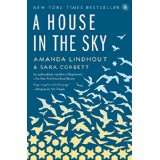Last week I stood in the book aisle at Target checking off the last items I needed to get before I left for a week retreat in Mexico. My list said, “book, not too light, not too heavy.”
Minutes passed and before I knew it I had five books stacked in front of me. I was stumped at which one I should choose for the week of beach time. So I plopped them in the front cart and continued checking off my list.
When I arrived at the checkout counter, before reading the summaries one last time, I spontaneously choose the blue book.
Packed in my suitcase was the blue book I selected, A House in the Sky. By the time I arrived on the beach, I had actually forgotten what it was about. I gave myself a couple hours every morning to read after teaching yoga and I enjoyed the story about the travels of young Amanda Lindhouth. In some ways she reminded me of my younger self. A young woman who loved to travel, experience different cultures, and enjoy the thrill of travelling to places that made me feel alive and curious.
However, on day three, as I sat in a lounge chair with a warm breeze, bright sun, clear skies, a full belly of a delicious organic breakfast and not a worry in the world, the detailed story began of her kidnapping and 462 days of extreme and cruel torture and rape.
I knew that she lived to tell the story, but I couldn’t read fast enough to get through the detailed precision of her captors gang rape, the 10 months lying on her side without seeing daylight, the animal fat delivered to her dark cell for her one meal a day . . . if she was lucky.
As I read her days, weeks, months and then year of torture and trauma, I was in some way traumatized by the details of her kidnapping. However, to put the book down and donate it to the lending library at the retreat center, felt like a betrayal to Amanda.
A deep dilemma emerged for me. At night, as I closed my eyes, the first thing I thought about was her and what it must have felt like to be in her situation. Images of her torture emerged like graphic pictures in my head. During meditation, which she practiced during her kidnapping, I felt the constriction and fear of her life. I couldn’t shake the images or the gripping. I had an uncomfortable feeling and I didn’t know whether the feelings were from my life or from hers.
For a couple of days I was mad at Amanda for putting herself in a situation that was clearly dangerous, even if it was out of the goodness of her heart.
However, I found that my anger, judgment, and disapproval were about my lack of capacity to hold the feelings that another human had been so inhumanely treated. I was also keenly aware that I was being served three nutritious meals a day and that my pressing concerns at the moment were trivial at best.
I gave myself afternoon breaks from reading and eventually finished the book as I swayed in a hammock, with a warm breeze listening to the waves crash onto the shore. For hours I was stunned. Part of me stunned that I had made it though the book. Part of me stunned that she made it out alive and continues to do good in the world.
As the shock and disbelief settled, what emerged for me was an unanswerable question that I wrestle with often, “how can I hold the deep agonizing pain of our world and the blessings and fortune of my life?”
Yes, Amanda’s story was extreme, but the truth is that torture and imprisonment is common and people are held hostage and kidnapped in many scenarios around the world even if they are considered “free.” People starving, displaced, tortured, raped, forgotten about, and helpless. Women, men, and children all around the world experience this as their reality.
And when I really contemplate what’s underneath my tense heart, fear, and anger, I recognize that I am genuinely sad, confused, and heartbroken that other human beings endure so much and in my own privileged life I feel helpless to change this.
It’s easier and more comfortable to turn away, put the book down, turn the channel and skim the photos. But what would happen if we paused and let the words sink in, looked into the eyes of the starving child, displaced women or felt the fear as bombs go off as the reporter tells the story?
I don’t have the answers to solve the humanitarian crisis in our world, but I do have the choice to not turn away from headlines, stories, and photos that make me uncomfortable with the pain of the world and the blessings of my life.
So I hold both, one in each hand, the blessings of life and the pain of life and know that both are true and have space to be in the human heart.
As I fly high above the clouds into the bright blue sky home to Chicago, I am reminded by the Buddhist practice of Tonglen in which we breathe in the pain and suffering of others so they can be well and gently breathe out peace and love or whatever we feel would bring them relief or happiness. That feels like a compassionate choice today.





